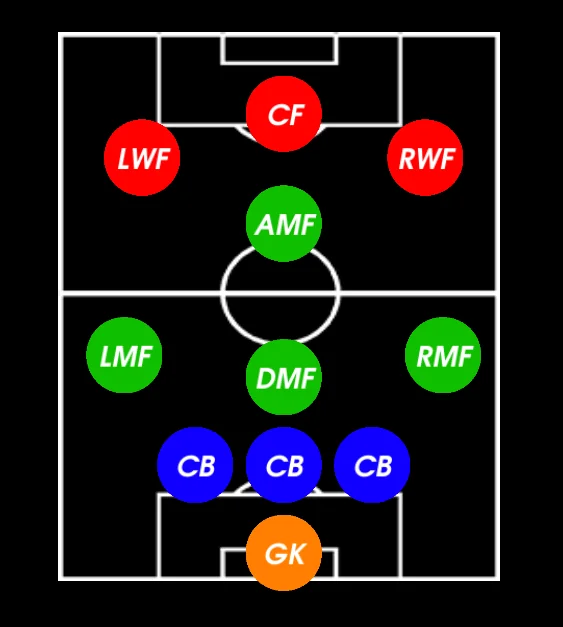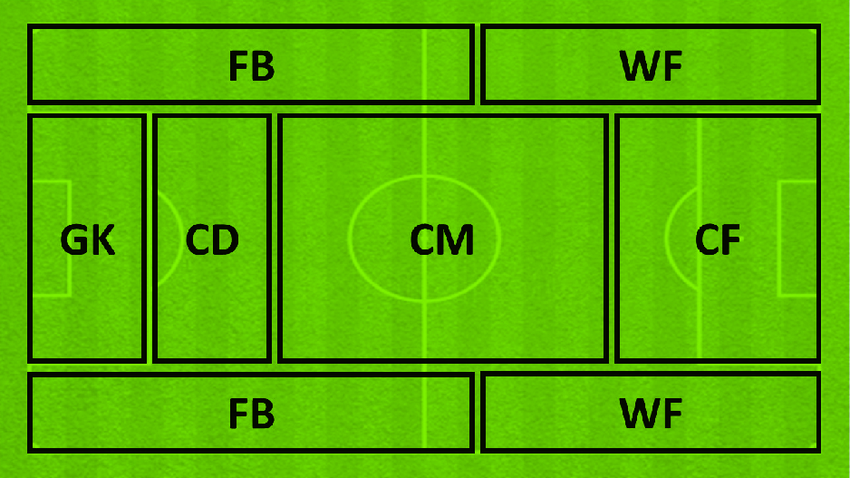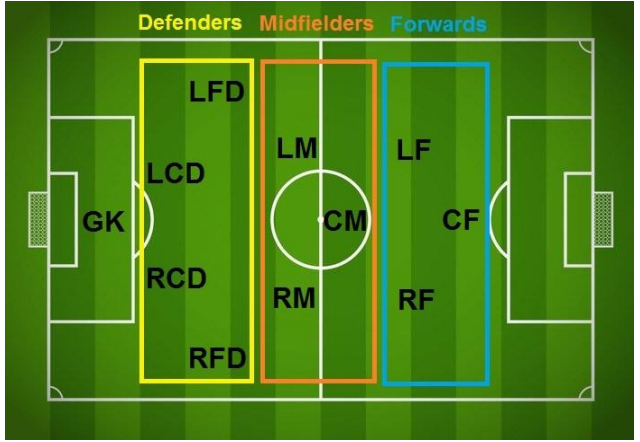In football, “CF” stands for “Center Forward.” The center forward is a position on the field, also known as the striker, and is typically positioned near the center of the offensive line. The main responsibility of a center forward is to score goals and lead the attacking plays for their team. They play a crucial role in the team’s offense and are often the primary goal-scoring threat.
Here, check out more knowledge about CF. Keep Reading!
The Vital Role of a Center Forward in Soccer

The center forward, also known as the striker, is super important in soccer. Most teams have one, except for some rare cases like Manchester City, who rotate their players. This position needs a ton of skill and discipline.
Moreover, a good center forward is like gold for a team because chances to score are rare, especially at the highest level of soccer. That’s why they often cost a lot of money they win games by scoring goals, and the more goals, the better.
Different tactics are used, like the 4-2-3-1 formation with one center forward or the 4-4-2 with two up front. Having two forwards can create great partnerships, like Sutton and Shearer or Henry and Bergkamp. These partnerships work well when the players have different skills that complement each other.
Also, being a center forward isn’t easy. They need to be confident and a bit selfish, always ready to score even if they don’t get the ball much. Sometimes they go through tough times where nothing seems to work, but if they stay confident, they’ll eventually score, and it might open the floodgates.
If a team plays with a lone center forward, it’s tough for them. They’re up against lots of defenders and need to be quick and strong. When the team doesn’t have the ball, they might feel a bit lonely waiting for the chance to score.
Lastly, it is similar to that of a hero. Everyone adores them when they win. However, it’s a demanding work with a lot of stress. When things are going well, a self-assured center forward is the team’s star and receives all the credit.
Unveiling the Distinctive Traits: Characteristics of an Exceptional Centre Forward in Soccer
In the dynamic realm of soccer, a Centre Forward (CF) transcends the boundaries of a mere position; it embodies a unique amalgamation of skills that sets it apart as the driving force of a team’s offensive prowess.
To comprehend the essence of an effective CF, one must dissect the distinct characteristics that elevate them to the zenith of goal-scoring excellence.
1. Clinical Goal-Scoring Prowess: Precision Personified
At the heart of a standout lies an innate and clinical ability to score goals. Whether orchestrating a powerful strike, executing finesse shots, or dominating the aerial game with headers, an effective CF embodies goal-scoring precision, consistently finding the back of the net when it matters most.
2. Technical Mastery: A Symphony with the Ball
The canvas of a world-class CF is painted with technical finesse. Mastery over the ball, impeccable ball control, and the capacity for intricate dribbling create a symphony on the field. This technical prowess not only allows them to navigate tight defenses but also facilitates seamless collaboration with teammates in the creation of scoring opportunities.
3. Physical Dominance: Aerial Supremacy and Strength Unleashed
In the physical chess match on the pitch, an effective CF stands as a towering presence. Aerial dominance, exemplified by an ability to win headers with precision, coupled with raw strength to outmuscle defenders, grants the CF a decisive advantage in goal-scoring situations.
Their physical prowess becomes a weapon, contributing not only to their personal success but also shaping the overall attacking dynamics of the team.
4. Intelligent Movement: Choreographing Offensive Symphony
The art of moving intelligently without the ball is a signature trait of an elite CF. Their runs are not just random sprints; they are a calculated dance, probing and dissecting defensive lines to create opportunities. The ability to read the game, exploit spaces, and orchestrate chaos in the opponent’s defense distinguishes an effective CF from the rest.
Variations in CF Play
Let’s delve into the diverse manifestations of CF play:
1. Traditional Centre Forwards: The Poetic Goal-Scorers
Characteristics:
- Traditional CFs excel in the penalty area, making them potent goal-scoring threats inside the box.
- Renowned for their prowess in winning aerial duels, they are a constant threat from crosses and set-pieces.
- Capable of holding off defenders, linking play, and involving teammates in the attacking build-up.
2. False 9s: The Playmaking Strikers
Characteristics:
- Instead of staying central, False 9s drop deep into the midfield, contributing to build-up play and creating numerical advantages.
- Known for deceptive movements, dragging defenders out of position and creating spaces for onrushing midfielders or wingers.
- While not anchored to the box, False 9s showcase versatility by scoring from various positions on the field.
3. Target Men: The Focal Point of Attack
Characteristics:
- Target Men rely on strength and stature to win long balls, hold off defenders, and create scoring opportunities.
- Act as a pivot, laying off balls to supporting midfielders or wingers, contributing significantly to the team’s offensive strategy.
- Often pivotal during set-pieces, using their aerial ability to score or create goal-scoring opportunities.
4. Poachers: The Opportunistic Finishers
Characteristics:
- Poachers thrive on predatory instincts, capitalizing on loose balls and defensive errors to score scrappy goals.
- Known for lightning-quick reactions in the box, pouncing on rebounds or deflections with clinical precision.
- Excel in finding spaces within the box, making well-timed runs to exploit defensive vulnerabilities.
Famous CFs in Modern Football

| Center Forward | Nationality | Current Club | Legacy/Attributes | Achievements/Records |
| Lionel Messi | Argentina | Paris Saint-Germain | Versatility Personified, Goal-Scoring Records, Consistent Excellence | Multiple Ballon d’Or winner |
| Cristiano Ronaldo | Portugal | Manchester United | Physical Prowess, Global Dominance, Work Ethic | Success in multiple leagues, relentless training |
| Robert Lewandowski | Poland | Bayern Munich | Goal-Machine, Record-Breaker, Team Player | Numerous goal-scoring records, intelligent movement |
| Karim Benzema | France | Real Madrid | Elegant Forward Play, Versatility, Big-Game Performer | Crucial goals, pivotal role in Real Madrid’s success |
| Erling Haaland | Norway | Borussia Dortmund | Raw Power and Pace, Clinical Scorer, Rapid Rise | Global sensation, goal-scoring exploits |
FAQ’s
What is the difference between FC and CF?
FC stands for Football Club in English, while CF stands for Club de Futbol in Spanish.
What is CB in football?
CB stands for Cornerback in American football, a position in the defensive backfield.
What is LF in football?
LF stands for Left Forward in football, indicating a player positioned on the left side of the forward line.
What means LM in football?
LM stands for Left Midfield in football, referring to a player positioned on the left side of the midfield.
Why is Real Madrid CF not FC?
Real Madrid CF’s full form is Real Madrid Club de Fútbol. Some teams use “CF” (Club de Fútbol) instead of “FC” (Fútbol Club) in their names; it’s a matter of tradition and preference.
What does SK mean in football?
“SK” in football does not have a widely recognized meaning in the context provided. It might refer to a specific club, and additional information would be needed for clarification.
Final Words
In the realm of football, “CF” holds significant meaning as it stands for “Center Forward.” This position is emblematic of goal-scoring prowess and offensive leadership on the field.
Moreover, it plays a vital role in shaping the outcome of a match, serving as the focal point for a team’s attacking strategies. As the embodiment of goal-scoring excellence, the CF position is integral to the narrative of football, contributing to the excitement and drama that defines the beautiful game.

